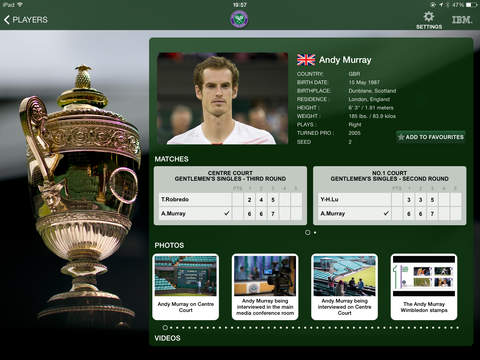At Wimbledon 2015 lead sponsor IBM was on display everywhere. From banners and screen ads, to television spots, IBM’s domineering sponsorship was felt. When the casual fan (myself included) watched these games it appeared that umpires were aided in officiating by not just IBM’s Hawkeye technology, but Apple iPads to display it. This was originally going to be a post about the presence of iPads at Wimbledon. However, as Mark Reschke of T-Gaap.com reported, the tablets at the All England Club were not iPads, but rather Panasonic’s Toughpad, running Windows.
Apple and IBM are well into a hundred million dollar partnership, one that has included such far ranging deals as IBM promoting iPads to elderly Japanese, IBM/Apple’s many business apps, software designed for banks, telecom, and utilities, issuing Apple’s products to employees, and even a brand new service for IBM clients that allows faster and more seamless integration of MacBooks within large companies. So with all that abundant and very public support and cooperation, why no iPads at Wimbledon? The answer is probably a boring one about All England Club contracts with other companies and legacy business deals. But it could just as easily be a serious marketing misstep.
Equally as odd as the lack of iPads at an IBM event, as Mark Reschke pointed out, is IBM’s under utilization of iPads in their high profile TV adverts. All current IBM ads show students or doctors using Windows equipment. Reschke says, justifiably, “perhaps someone in IBM corporate will inform their sports analytics team, marketing department, and advertising agency” about their current partnerships with Apple. Contacts with other companies, namely Sony, aside, there shouldn’t be a huge barrier to IBM using the littlest amount of leverage to get iPads into Wimbledon, or simply putting them in their minute-long TV spots seen by millions of people across the globe.

The only place Apple products were seen at Wimbledon? In the stands of course. Hoards of fans filmed the tennis action on their iPads and iPhones, uploading great quality video. Fan videos sometimes show, among other things, how Sony’s “Hawk-Eye” was getting some calls wrong. Hawk-Eye has a history of criticism, some from the Australian media regarding its use in cricket, another relating to a controversial call during Nadal-Federer in Wimbledon 2008, in which Hawk-Eye declared a ball in by 1mm, less than its 3.6 mm margin for error, and numerous peer-reviewed journal pieces calling into question the technology’s stated ability to predict trajectory. Tennis experts have also questioned whether or not the technology ignores factors like distortion of the ball on bouncing, and the human errors inherent in a court painted on the ground by people.
This is all to bring up another valid point, why has the much beleaguered Sony system, with a 3.6mm margin of error, not been replaced with better software and better cameras, like those sometimes found on Apple products? Prior contracts and commitments no doubt, but the sporting world is being short changed, and so is Apple.





